
In The Grove Of The Temple Of Isis
In The Grove Of The Temple Of Isis c1915 by British Painter John William Godward (1861 – 1922), czyja kariera trwała do końca ery neoklasycznej?. Malował także w symbolizmie, Estetyka i akademickie style ruchu artystycznego
In The Grove Of The Temple Of Isis is an eye catching portrait of a raven haired beauty with a red scarf tied around her hair, wearing a red gemstone necklace, a matching red cord tied above her waist, a violet gown with light blue trimming along the perimeter, and a golden colored apron tied around her waist with the same blue trimming that is hanging below her knees.

She has the back of her bent left hand positioned on her hip and in her extended right hand she is holding a decorative tambourine that is resting on the upper portion of her right thigh.
She is standing a massive aged white marble platform that is part of a staircase; and on that platform is a massive sculpted art nouveau lion that seems to have been fashioned out of copper, as we can see some visible copper color under green patina of the sculpture.
Behind that is a very large tree with pink flowers set against a light blue sky and farther off in the distance we see a partial landscape with trees, plants and grass; as well as an ocean with a large boulder protruding from the surface of the water.
In The Grove Of The Temple Of Isis is a remastered digital art old masters reproduction of a public domain image that is available as metal, akryl i wydruki na płótnie online.
Informacje poniżej od Wikipedia.org
John William Godward was the eldest of five children, i został nazwany na cześć swojego ojca Johna i dziadka Williama.
He exhibited at the Royal Academy from 1887. When he moved to Italy with one of his models in 1912, his family broke off all contact with him and even cut his image from family pictures. Godward returned to England in 1921, died in 1922, and is buried in Brompton Cemetery, West London.
One of his best-known paintings is Dolce far Niente (1904), which was purchased for the collection of Andrew Lloyd Webber in 1995. As in the case of several other paintings, Godward painted more than one version; in this case, an earlier (and less well-known) 1897 version with a further 1906 version.
He committed suicide at the age of 61 and is said to have written in his suicide note that “the world is not big enough for [both] myself and a Picasso”.
His estranged family, who had disapproved of his becoming an artist, were ashamed of his suicide and burned his papers. Only one photograph of Godward is known to survive.
Godward był wiktoriańskim neoklasykiem, i dlatego, W teorii, wyznawca Frederica Leightona. jednak, jest bliższy stylistycznie sir Lawrence'owi Alma-Tadema, z którym dzielił upodobanie do oddawania architektury klasycznej – w szczególności, statyczne elementy krajobrazu zbudowane z marmuru.
The vast majority of Godward’s extant images feature women in classical dress posed against landscape features; although there are some semi-nude and fully nude figures included in his oeuvre, a notable example being “In The Tepidarium c1913”.
A title shared with a controversial Alma-Tadema painting of the same subject that resides in the “Lady Lever Art Gallery”. The titles reflect Godward’s source of inspiration; which was classical civilization, most notably that of Ancient Rome; a subject binding Godward closely to Alma-Tadema artistically.
Given that Classical scholarship was more widespread among the potential audience for his paintings during his lifetime than in the present day, meticulous research of detail was important in order to attain a standing as an artist in this genre.
Alma-Tadema was an archaeologist as well as a painter, who attended historical sites and collected artifacts he later used in his paintings: Boski, too, studied such details as architecture and dress, in order to ensure that his works bore the stamp of authenticity.
Ponadto, Godward painstakingly and meticulously rendered other important features in his paintings, animal skins of which the paintings “Noon Day Rest c1910” i “A Cool Retreat c1910” contains examples of such rendition as well as wildflowers “Nerissa c1906” i “Summer Flowers c1903”.
The appearance of beautiful women in studied poses in so many of Godward’s canvases causes many newcomers to his works to categorize him mistakenly as being Pre-Raphaelite, particularly as his palette is often a vibrantly colorful one. The choice of subject matter (ancient civilization versus, na przykład, Arthurian legend) is more properly that of the Victorian Neo-classicist.
In common with numerous painters contemporary with him, Godward was a ‘High Victorian Dreamer’, producing images of an idealized and romanticized world that, in the case of both Godward and Alma-Tadema, came to be criticized as a world-view of Victorians in togas.
Boski “quickly established a reputation for his paintings of young women in a classical setting and his ability to convey with sensitivity and technical mastery the feel of contrasting textures of flesh, marble, fur and fabrics.
Godward’s penchant for creating works of art set in the classical period probably came from the time period in which he was born; as it was the last full-scale classical revival in western paintings, that flourished in England from the 1860s up until the 1890s.



